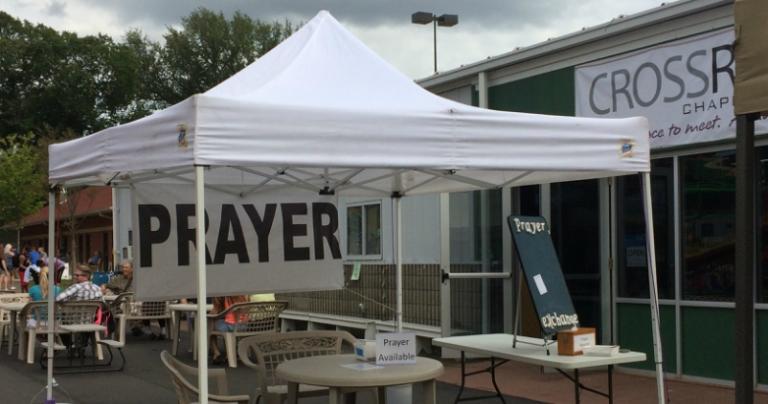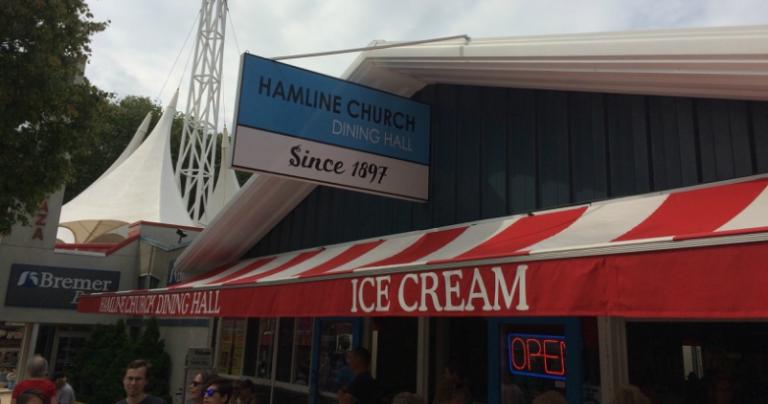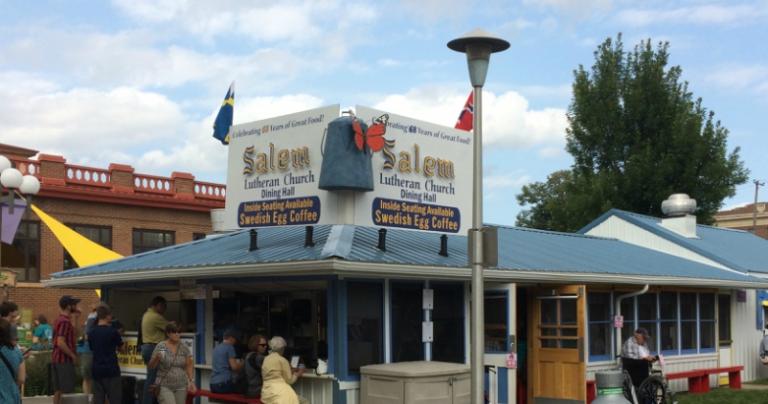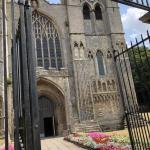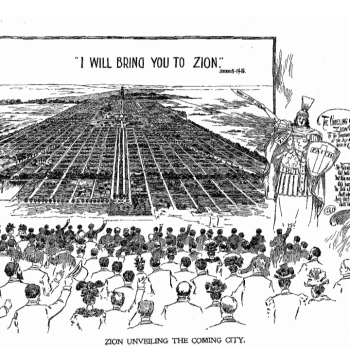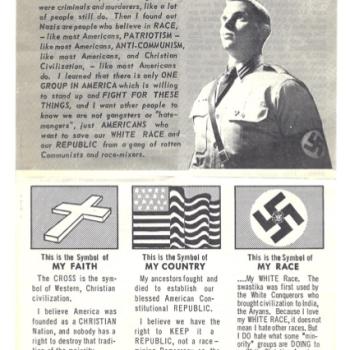Both because I’ve been traveling all weekend and because we’re entering county/state fair season in my part of the U.S.A., I thought I’d rerun this post from last August (with minor updates). I’ll be back with new material next week.
I’m sure I have colleagues on the Anxious Bench who will want to advocate for the justly renowned state fairs of Texas and Iowa. (And when I first posted this piece, Philip pointed my attention to the venerable Grange Fair of central Pennsylvania, whose 1994 New York Times profile began with four singing Methodist ministers.) But to my mind, there’s nothing quite like what happens this time of year in my home state. As measured by average daily attendance, the Minnesota State Fair is the country’s largest. We broke the record last year, with almost 2 million people getting together for the dozen days of the Great Minnesota Get Together — over 240,000 just on the Sunday before Labor Day.
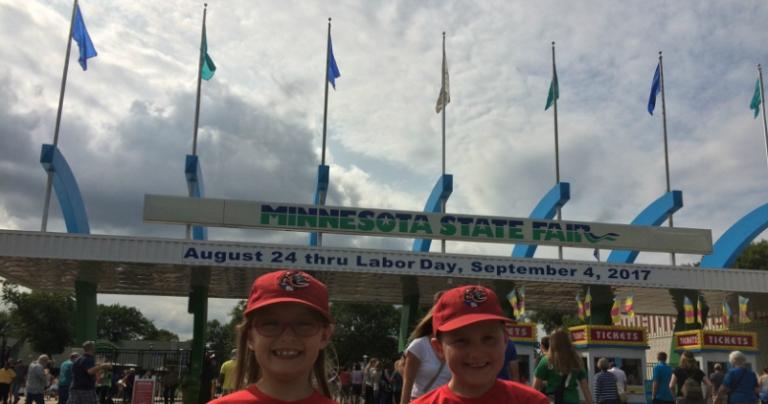
Last year 117,877 of our closest friends joined my kids and me for opening day. Thanks to some unusually comfortable August weather, we lasted for more than five hours: eating food, going on rides, eating food, admiring farm animals, eating food, listening to music, and, yes, eating food.
Fortunately, my iPhone tells me that we walked nearly seven miles, so I’m hoping we burned off at least a few of those calories.
But with an eye to this blog post, I managed to tear my attention away from cheese curds and livestock long enough to think about the many ways that religion shows up in this kind of event.
Any site that draws nearly two million visitors in less than two weeks is likely to be a popular spot for evangelism. As we got on our bus to head home, we watched a bearded man walk by holding a banner bearing one of the more ominous sentences in the King James Bible: “The wicked shall be turned into hell, and all the nations that forget God.” (Ps 9:17)
But such activity is less common and more tightly regulated than you might think, in part because of a landmark religious liberty case that pitted the organization that administers the Minnesota State Fair against a well-known Eastern religious group. In Heffron v. International Society for Krishna Consciousness (1981) the U.S. Supreme Court agreed that the fair could restrict how the Hare Krishna distributed religious literature, requiring them to register and rent space. Without such rules, wrote Byron White for the 5-4 majority, “there would be widespread disorder at the fairgrounds…. Obviously, there would be a much larger threat to the State’s interest in crowd control if all other religious, nonreligious, and noncommercial organizations could likewise move freely about the fairgrounds distributing and selling literature and soliciting funds at will.” (A more recent case involved an evangelical preacher who was barred from walking around the Texas State Fair passing out biblical tracts.)
Back at the time of Heffron, the list of religious exhibitors at the Minnesota State Fair included Lutheran Colportage Service, the World Home Bible League, Twin Cities Baptist Messianic Witness, and the Christian Business Men’s Association. I didn’t see nearly as many exhibits of that sort last week, but there are still some notably religious buildings on the grounds.
Albeit not as grand as the Hall of Religion that once stood in Texas’ Fair Park, the non-denominational Crossroads Chapel has welcomed Minnesotans since 1954, when it was founded as the Gospel Tent. “Crossroads,” explains its magazine, “offers a conduit to interact daily with the lost and effect real life change that can only occur when one is introduced to Jesus Christ.” One volunteer calls it a “short term local missions trip… a way of life, a calling that God has brought us to, a desire so strong that there is no way we could stay away.”
Local church praise teams take turns performing at Crossroads, and volunteers help kids with craft projects and offer to pray for visitors. You can buy books by Billy Graham and Lecrae in the chapel store — or pick up a free Bible from the Gideon tent just outside. (And it’s not just Christians giving away scripture at such fairs.) The chapel also hosts worship services on the fair’s two Sunday mornings.
Visitors can also take Mass at one of the fair’s many musical stages or participate in an ecumenical prayer service at another — a bandshell sponsored by a Wisconsin brewery. But the most famous religious buildings in the history of state fairs aren’t worship spaces at all. They’re restaurants.
By 1903 most of the Minnesota State Fair’s eighty-nine dining halls were run by churches. While some turn-of-the-century patrons decried “[t]he gastric crimes which are committed on the fair ground in the name of religion,” historian Karal Ann Marling observes that
the church cook tent and the agricultural fair were bound together in a symbiotic relationship that went back to pioneer days…. The appeal of eating “sacerdotal baked beans, cooked and served by benevolent ladies in the interests of Christ and a new carpet for the pastor’s study” was a powerful one; those who did not seek out the Presbyterians, Methodists, or the Catholics for reasons of piety or charity did so because the food was apt to be of the homemade variety — familiar and filling.
Many of these facilities didn’t survive the Great Depression. While they started to revive in popularity after World War II, the church dining hall has declined again in recent decades — thanks to everything from rising meat prices to changing culinary tastes to tightening state regulations to the eternal ecclesial challenge of finding enough volunteers.
In Minnesota two churches still run state fair dining halls: the United Methodist church that stands across the street from Hamline University in St. Paul; and Salem Evangelical Lutheran in North Minneapolis. Our fair day began at the 120-year old Hamline Church Hall, where I learned that it takes sixty volunteers a day to keep things running. “The esprit de corps is more important than the profit,” Marling quoted the woman who ran the dining hall in the 1960s. “In a big city church, members of the congregation are often strangers to each other. Working together out here we become friends.”
But there are other reasons. Why keep the tradition alive?, I asked the man dishing up mint chocolate chip cream for the kids. “Fundraising,” he replied, “and mission.” This year a portion of their proceeds will be given to Feed My Starving Children, a Twin Cities-based nonprofit that packs meals for people around the world, and to a local elementary school whose poorest students often go without meals during the weekend.
Supper time brought us to Salem Lutheran’s relatively new hall (a mere 65 years old), where volunteers from a Christian community development organization served me Swedish meatballs washed down by Swedish egg coffee. (Yes, that’s a thing.) “I think we forgot to pray,” my son gently reminded me — pointing up at a laminated print-out of our favorite table grace, displayed next to the price of ice cream cones. Beyond fundraising, the church also takes advantage of the dining hall’s proximity to the fair’s “Eco Connections” building to articulate one aspect of its mission. “As Lutherans,” explains a sign outside, “we believe in caring for the earth that cares for us” — e.g., by composting and using locally-sourced ingredients.
Four hours to the south of us, the Iowa State Fair hosted a “Church Row” of Christian dining halls for about nine decades. In its best year, for example, Des Moines’ Basilica of St. John hosted a barbecue place — ”Brother Bubba’s” — that raised as much as $13,000 a year. But it couldn’t find enough volunteers and struggled to compete with trendier, cheaper dining options. The oldest of the Protestant venues closed in 2002 when its sponsoring church couldn’t afford $30,000 in needed repairs.
Now, just one Methodist dining hall remains. “Saddle up to their stand,” reported the Des Moines Register earlier this month, “and amid menus and napkins and table salt, you’ll find their speared offering: a prayer — on a tongue depressor.”



